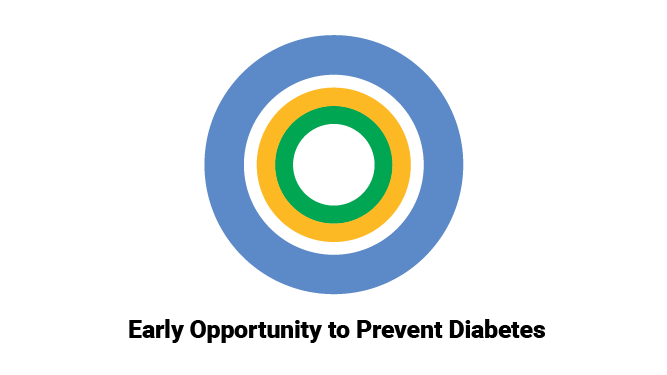



Prediabetes and Risk of Mortality, Diabetes-Related Complications, and Comorbidities


The term “Prediabetes” is used to define the intermediate state of blood glucose levels ranging between the normal glycemic level and diabetes. Prediabetes is characterized by the simultaneous presence of insulin resistance and beta-cell dysfunction, abnormalities that are detectable before the onset of T2DM. (1 )
Prediabetes often flies under the radar because
Significance of Screening Strategies for Prediabetes, Diabetes, and Associated Complications
Importance of Dietary Proteins in management of Prediabetes and Type 2 Diabetes
To Read More
Hence, the World Health Organization uses the term ‘Intermediate Hyperglycaemia’ and an International Expert Committee convened by the ADA consented to use the term ‘High-Risk State of Developing Diabetes’ rather than ‘prediabetes’. The committee also issued a set of guidelines, that clarified that the definition of prediabetes is met if at least one of the following criteria is seen in the individual, that is
Several observational studies have shown a link between prediabetes and hypertension, dyslipidemia, an early form of neuropathy, chronic kidney disease, retinopathy, cancer, breast cancer, all-cause dementia, etc. (5)

In a prediabetic state, insulin resistance and hyperinsulinemia play pivotal roles in the pathogenesis of high blood pressure. The coexistence of insulin resistance and hypertension can be viewed as a cause-effect relationship. Insulin can increase blood pressure via several mechanisms:
Conversely, hypertension can cause insulin resistance resulting in prediabetes by altering the delivery of insulin and glucose to skeletal muscle cells, resulting in impaired glucose uptake. (6)

Prediabetic individuals are more likely to be obese than others, regardless of their age or body mass index. Hence, the typical pattern of dyslipidemia in prediabetes is similar to type 2 diabetes, which includes hypertriglyceridemia, reduced HDL cholesterol (HDL-C), and increased small dense atherogenic LDL particles.
Several studies have suggested that low HDL cholesterol is an independent factor not only for diabetes but also for the development of cardiovascular diseases. Along with the presence of small dense LDL particles, it may contribute to accelerated atherosclerosis even before diabetes is formally diagnosed. (5)

Macrovascular complications from prediabetes typically arise due to atherosclerosis due to its coexistence with other metabolic syndromes. In addition, an increase in fibrinogen and high-sensitivity C-reactive protein is usually observed in prediabetic individuals in comparison to normoglycemic patients.
Other factors that link prediabetes and cardiovascular complications are the abundance of Western-style diets and decreased physical activity. Abnormalities induced by an unhealthy high-fat high-carbohydrate diet, include changes in the concentration of triglycerides, high-density lipoprotein cholesterol (HDL-C), and low-density lipoprotein cholesterol (LDL-C). These changes in the lipid profile further increase markers of oxidative stress, such as C-reactive protein as well as endothelial nitric oxide synthase (eNOS) resulting in inflammation as well as high blood pressure. Hence, it can be concluded that hypertension, dyslipidemia, and prediabetes co-cluster in the susceptible population and act synergistically to increase coronary artery disease risk. (1)

Fear of progression to T2DM or anxiety about the changes and consequences of diabetes have a tangible effect on the mental health of a prediabetic individual. Similarly, changes in the blood sugar level can trigger rapid changes in mood, fatigue, anxiety, etc.
A healthy lifestyle increases the chances of reverting to the normoglycemic stage, but lifestyle behaviors such as smoking, unhealthy eating habits, and physical inactivity are common in people with depressive and anxiety symptoms and these symptoms might increase the risk of progressing from prediabetes to type 2 diabetes. Though prediabetes and depressive and anxiety symptoms are uniquely associated with an increased risk of diabetes, the combination of prediabetes and depressive or anxiety symptoms might amplify this risk.
Hence, this idea of prediabetes used for individuals with impaired glucose metabolism is important because of its high prevalence and increased risk of progression to type diabetes. In other words, it can be said that prediabetes represents a time window of opportunity in which modifiable risk factors of diabetes, such as obesity, a diet high in carbohydrates, and a physically inactive lifestyle can be targeted to prevent or delay the development of type 2 diabetes. (3) (4)
Resources
1. https://link.springer.com/article/10.1007 /s00125-021-05592-3
2. https://www.sciencedirect.com/science /article/abs /pii/S0140673612602839
4. https://www.sciencedirect.com /science/article /abs/pii/S0022399916303774?via%3Dihub
5. https://www.diabetesresearchclinicalpractice .com /article/S0168-8227(22)00794-X/fulltext
Significance of Screening Strategies for Prediabetes, Diabetes, and Associated Complications
Importance of Dietary Proteins in management of Prediabetes and Type 2 Diabetes
To Read More
USV Private Limited will assume no responsibility to any person who relies on information contained on this Site and shall disclaim all liability in respect to such information. You should not act upon information on this Website without seeking Medical advice from a licensed health care practitioner
User should not allow the contents of this Website to substitute his/ her own judgment which he/she should exercise in evaluating the information in this Website. User agrees that the Services Provider on the Website may not be available at the time provided on the website or may discontinue their association with this Website.
Service Provider shall be solely responsible for assuring that he/she/it has the valid license(s) and registration with concerned statutory authorities to practice and shall abide by all applicable laws. Breach of this condition will make concerned Service Provider entirely liable for legal action or other consequences arising there from.
While due care and caution has been taken to ensure that this Site is free from mistakes or omission, USV Private Limited shall not be responsible in any manner whatsoever, for any action taken, opinions expressed, advice rendered or accepted, any direct incidental, special or consequential loss and damage caused based on any material or information published on this Website.
While due care and caution has been taken to ensure that this Site is free from mistakes or omission, USV Private Limited shall not be responsible in any manner whatsoever, for any action taken, opinions expressed, advice rendered or accepted, any direct incidental, special or consequential loss and damage caused based on any material or information published on this Website.
Discalmer :
The information provided herein is only intended to bring general awareness among the users and the same shall not be considered as a substitute for medical advice. Readers shall consult their registered medical practitioners before taking any drug and using the information. USV Private Limited does not promote use of any drug nor validate the content referred in the reference . links provided herein and disclaim all the liabilities arising from use of the information. Copying, circulation and distribution of this content is strictly prohibited.
